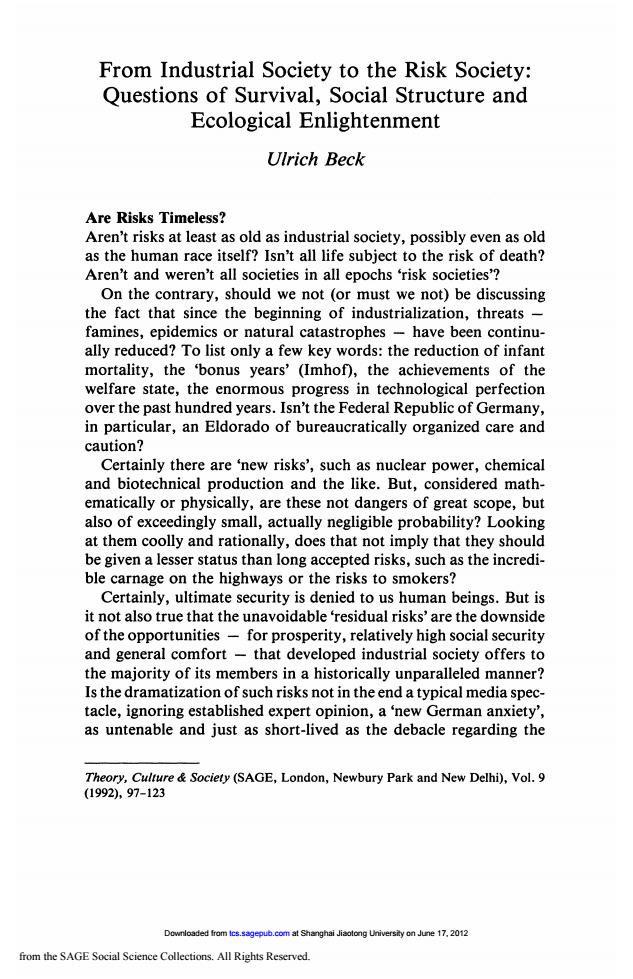
From Industrial Society to the Risk Society: Questions of Survival,Social Structure and Ecological Enlightenment Ulrich Beck Are Risks Timeless? Aren't risks at least as old as industrial society,possibly even as old as the human race itself?Isn't all life subject to the risk of death? Aren't and weren't all societies in all epochs‘risk societies'? On the contrary,should we not (or must we not)be discussing the fact that since the beginning of industrialization,threats famines,epidemics or natural catastrophes have been continu- ally reduced?To list only a few key words:the reduction of infant mortality,the 'bonus years'(Imhof),the achievements of the welfare state,the enormous progress in technological perfection over the past hundred years.Isn't the Federal Republic of Germany, in particular,an Eldorado of bureaucratically organized care and caution? Certainly there are new risks',such as nuclear power,chemical and biotechnical production and the like.But,considered math- ematically or physically,are these not dangers of great scope,but also of exceedingly small,actually negligible probability?Looking at them coolly and rationally,does that not imply that they should be given a lesser status than long accepted risks,such as the incredi- ble carnage on the highways or the risks to smokers? Certainly,ultimate security is denied to us human beings.But is it not also true that the unavoidable 'residual risks'are the downside of the opportunities for prosperity,relatively high social security and general comfort that developed industrial society offers to the majority of its members in a historically unparalleled manner? Is the dramatization of such risks not in the end a typical media spec- tacle,ignoring established expert opinion,a‘new German anxiety', as untenable and just as short-lived as the debacle regarding the Theory,Culture Society (SAGE,London,Newbury Park and New Delhi),Vol.9 (1992),97-123 Downloaded from ics.sagepub.com at Shanghai Jiaotong University on June 17.2012 from the SAGE Social Science Collections.All Rights Reserved
from the SAGE Social Science Collections. All Rights Reserved. Downloaded from tcs.sagepub.com at Shanghai Jiaotong University on June 17, 2012

98 Theory,Culture Society 'railroad sickness'from the end of the preceding century? And finally,aren't risks a central concern of the engineering and physical sciences?What business has the sociologist here?Isn't that once again typical? The Calculus of Risk:Predictable Security in the Face of an Open Future Human dramas -plagues,famines and natural disasters,the looming power of gods and demons-may or may not quantifiably equal the destructive potential of modern mega-technologies in hazardousness.They differ essentially from 'risks'in my sense since they are not based on decisions,or more specifically,decisions that focus on techno-economic advantages and opportunities and accept hazards as simply the dark side of progress.This is my first point: risks presume industrial,that is,techno-economic decisions and considerations of utility.They differ from 'war damage'by their 'normal birth',or more precisely,their 'peaceful origin'in the cen- tres of rationality and prosperity with the blessings of the guarantors of law and order.They differ from pre-industrial natural disasters by their origin in decision-making,which is of course never con- ducted by individuals but by entire organizations and political groups.! The consequence is fundamental:pre-industrial hazards,no matter how large and devastating,were 'strokes of fate'raining down on mankind from 'outside'and attributable to an 'other'- gods,demons or Nature.Here too there were countless accusations, but they were directed against the gods or God,religiously motiv- ated',to put it simply,and not like industrial risks-politically charged.For with the origin of industrial risks in decision-making the problem of social accountability and responsibility irrevocably arises,even in those areas where the prevailing rules of science and law permit accountability only in exceptional cases.People,firms, state agencies and politicians are responsible for industrial risks.As we sociologists say,the social roots of risks block the 'external- izability'of the problem of accountability.2 Therefore,it is not the number of dead and wounded,but rather a social feature,their industrial self-generation,which makes the hazards of mega-technology a political issue.The question remains however:must one not view and assess the past 200 years as a period of continual growth in calculability and precautions in dealing with industrially produced insecurities and destruction?In fact,a very Downloaded from lcs.sagepub.com at Shanghai Jiaotong University on June 17,2012
Downloaded from tcs.sagepub.com at Shanghai Jiaotong University on June 17, 2012
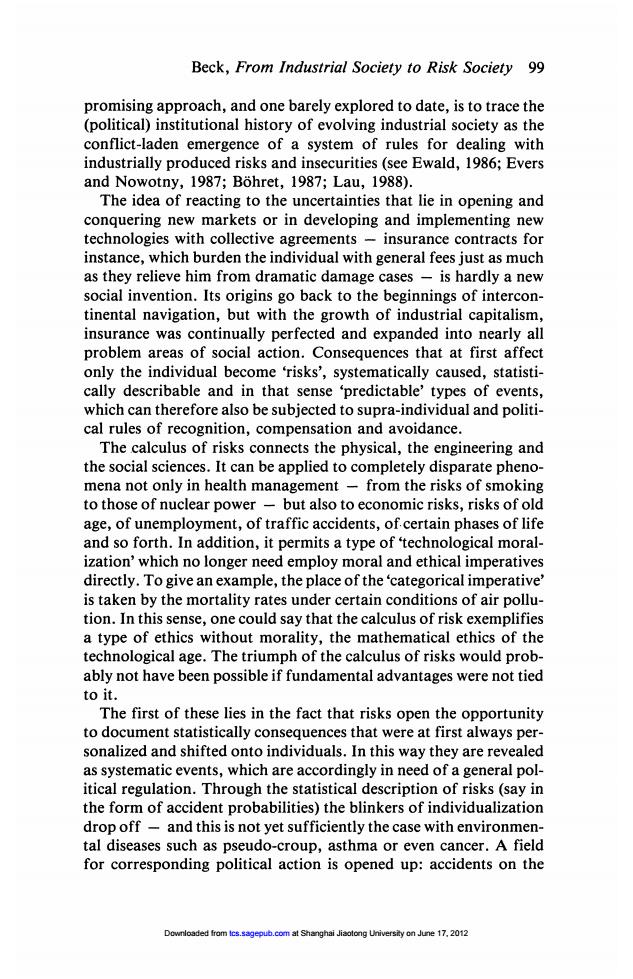
Beck,From Industrial Society to Risk Society 99 promising approach,and one barely explored to date,is to trace the (political)institutional history of evolving industrial society as the conflict-laden emergence of a system of rules for dealing with industrially produced risks and insecurities (see Ewald,1986;Evers and Nowotny,1987;Bohret,1987;Lau,1988). The idea of reacting to the uncertainties that lie in opening and conquering new markets or in developing and implementing new technologies with collective agreements-insurance contracts for instance,which burden the individual with general fees just as much as they relieve him from dramatic damage cases-is hardly a new social invention.Its origins go back to the beginnings of intercon- tinental navigation,but with the growth of industrial capitalism, insurance was continually perfected and expanded into nearly all problem areas of social action.Consequences that at first affect only the individual become 'risks',systematically caused,statisti- cally describable and in that sense 'predictable'types of events, which can therefore also be subjected to supra-individual and politi- cal rules of recognition,compensation and avoidance. The calculus of risks connects the physical,the engineering and the social sciences.It can be applied to completely disparate pheno- mena not only in health management -from the risks of smoking to those of nuclear power-but also to economic risks,risks of old age,of unemployment,of traffic accidents,of certain phases of life and so forth.In addition,it permits a type of 'technological moral- ization'which no longer need employ moral and ethical imperatives directly.To give an example,the place of the 'categorical imperative' is taken by the mortality rates under certain conditions of air pollu- tion.In this sense,one could say that the calculus of risk exemplifies a type of ethics without morality,the mathematical ethics of the technological age.The triumph of the calculus of risks would prob- ably not have been possible if fundamental advantages were not tied to it. The first of these lies in the fact that risks open the opportunity to document statistically consequences that were at first always per- sonalized and shifted onto individuals.In this way they are revealed as systematic events,which are accordingly in need of a general pol- itical regulation.Through the statistical description of risks (say in the form of accident probabilities)the blinkers of individualization drop off-and this is not yet sufficiently the case with environmen- tal diseases such as pseudo-croup,asthma or even cancer.A field for corresponding political action is opened up:accidents on the Downloaded from lcs.sagepub.com at Shanghai Jiaotong University on June 17,2012
Downloaded from tcs.sagepub.com at Shanghai Jiaotong University on June 17, 2012

100 Theory,Culture Society job,for instance,are not blamed on those whose health they have already ruined anyway,but are stripped of their individual origin and related instead to the plant organization,the lack of precautions and so on. A second advantage is closely connected to the first:insurance payments are agreed on and guaranteed on a no-fault basis(setting aside the extreme cases of gross negligence or intentional damage). In that way,legal battles over causation become unnecessary and moral outrage is moderated.Instead,an incentive for prevention is created for businesses,in proportion to the magnitude of the insurance costs -or perhaps not. The decisive thing,however,is ultimately that in this manner the industrial system is made capable of dealing with its own unfore- seeable future.The calculus of risks,protection by insurance liability laws and the like promise the impossible:events that have not yet occurred become the object of current action-prevention, compensation or precautionary after-care.As the French sociologist Francois Ewald (1986)shows in detailed studies,the 'invention'of the calculus of risks lies in making the incalculable calculable, with the help of accident statistics,through generalizable settlement formulae as well as through the generalized exchange principle of 'money for damages'.In this way,a norm system of rules for social accountability,compensation and precautions,always very controversial in its details,creates present security in the face of an open uncertain future.Modernity,which brings uncertainty to every niche of existence,finds its counter-principle in a social com- pact against industrially produced hazards and damages,stitched together out of public and private insurance agreements. Politically and programmatically,this pact for the containment and 'just'distribution of the consequences of the standard industrial revolution is situated somewhere between socialism and liberalism, because it is based on the systematic creation of consequences and hazards,but at the same time involves individuals in preventing and compensating for them.The consensus that can be achieved with it always remains unstable,conflict-laden and in need of revi- sion.For that very reason,however,it represents the core,the inner 'social logic'of the consensus on progress,which-in principle- legitimated techno-economic development in the first phase of industrialism.Where this security pact'is violated wholesale, flagrantly and systematically,the consensus on progress itself is consequently at stake. Downloaded from tcs.sagepub.com at Shanghai Jiaotong University on June 17.2012
Downloaded from tcs.sagepub.com at Shanghai Jiaotong University on June 17, 2012
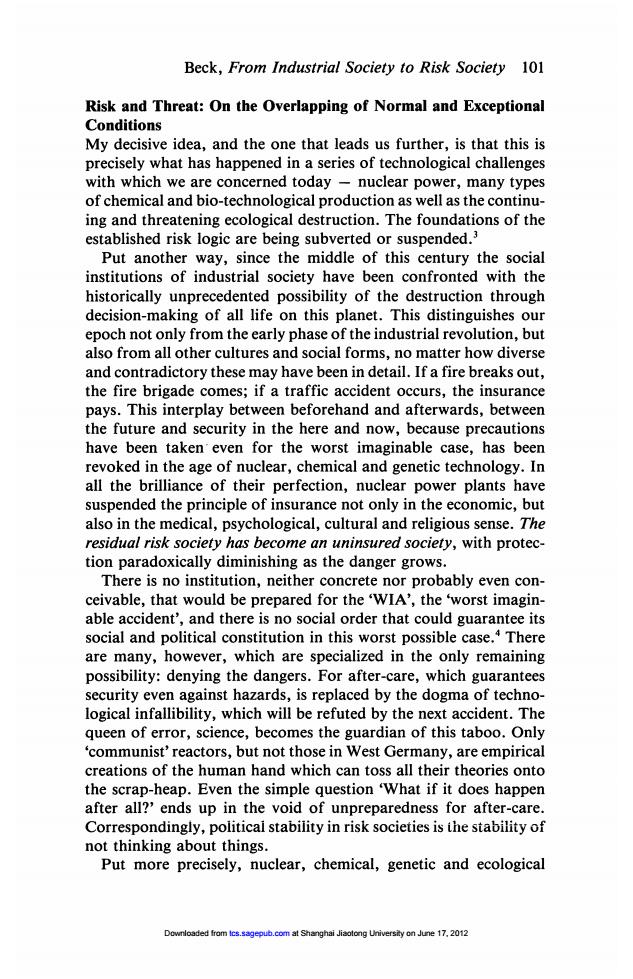
Beck,From Industrial Society to Risk Society 101 Risk and Threat:On the Overlapping of Normal and Exceptional Conditions My decisive idea,and the one that leads us further,is that this is precisely what has happened in a series of technological challenges with which we are concerned today -nuclear power,many types of chemical and bio-technological production as well as the continu- ing and threatening ecological destruction.The foundations of the established risk logic are being subverted or suspended.3 Put another way,since the middle of this century the social institutions of industrial society have been confronted with the historically unprecedented possibility of the destruction through decision-making of all life on this planet.This distinguishes our epoch not only from the early phase of the industrial revolution,but also from all other cultures and social forms,no matter how diverse and contradictory these may have been in detail.If a fire breaks out, the fire brigade comes;if a traffic accident occurs,the insurance pays.This interplay between beforehand and afterwards,between the future and security in the here and now,because precautions have been taken'even for the worst imaginable case,has been revoked in the age of nuclear,chemical and genetic technology.In all the brilliance of their perfection,nuclear power plants have suspended the principle of insurance not only in the economic,but also in the medical,psychological,cultural and religious sense.The residual risk society has become an uninsured society,with protec- tion paradoxically diminishing as the danger grows. There is no institution,neither concrete nor probably even con- ceivable,that would be prepared for the 'WIA',the 'worst imagin- able accident',and there is no social order that could guarantee its social and political constitution in this worst possible case.4 There are many,however,which are specialized in the only remaining possibility:denying the dangers.For after-care,which guarantees security even against hazards,is replaced by the dogma of techno- logical infallibility,which will be refuted by the next accident.The queen of error,science,becomes the guardian of this taboo.Only communist'reactors,but not those in West Germany,are empirical creations of the human hand which can toss all their theories onto the scrap-heap.Even the simple question 'What if it does happen after all?'ends up in the void of unpreparedness for after-care. Correspondingly,political stability in risk societies is the stability of not thinking about things. Put more precisely,nuclear,chemical,genetic and ecological Downloaded from lcs.sagepub.com at Shanghai Jiaotong University on June 17,2012
Downloaded from tcs.sagepub.com at Shanghai Jiaotong University on June 17, 2012

102 Theory,Culture Society mega-hazards abolish the four pillars of the calculus of risks.First, one is concerned here with global,often irreparable damage that can no longer be limited;the concept of monetary compensation therefore fails.Second,precautionary after-care is excluded for the worst imaginable accident in the case of fatal hazards;the security concept of anticipatory monitoring of results fails.Third,the 'acci- dent'loses its delimitations in time and space,and therefore its meaning.It becomes an event with a beginning and no end;an open-ended festival'of creeping,galloping and overlapping waves of destruction.But that implies:standards of normality,measuring procedures and therefore the basis for calculating the hazards are abolished;incomparable entities are compared and calculation turns into obfuscation. The problem of the incalculability of consequences and damage becomes clear with particular vividness in the lack of accountability for them.The scientific and legal recognition and attribution of hazards takes place in our society according to the principle of causality,the polluter-pays principle.But what strikes engineers and lawyers as self-evident,even virtually demanded by ethics,has extremely dubious,paradoxical consequences in the realm of mega- hazards.One example:the legal proceedings against the lead crystal factory in the community of Altenstadt in the Upper Palatinate (reported in Der Spiegel 46,1986:32ff). Flecks of lead and arsenic the size of a penny had fallen on the town,and fluoride vapours had turned leaves brown,etched windows and caused bricks to crumble away.Residents were suffer- ing from skin rashes,nausea and headaches.There was no question where all of that originated.The white dust was pouring visibly from the smokestacks of the factory.A clear case.A clear case?On the tenth day of the trial the presiding judge offered to drop charges in return for a fine of DM 10,000,a result which is typical of environ- mental crimes in the Federal Republic (1985:13,000 investigations, twenty-seven convictions with prison terms,twenty-four of those suspended,the rest dropped). How is that possible?It is not only the lack of laws and not merely the legendary shortcomings in applying them which protect the criminals.The reasons lie deeper and cannot be eliminated by the staunch appeals to the police and the law-makers that issue ever more loudly from the ranks of the environmentalists.A conviction is blocked by the very thing that was supposed to achieve it:the strict application of the(individually interpreted)polluter-pays principle. Downloaded from lcs.sagepub.com at Shanghai Jiaotong University on June 17,2012
Downloaded from tcs.sagepub.com at Shanghai Jiaotong University on June 17, 2012

Beck,From Industrial Society to Risk Society 103 In the case of the lead crystal factory,the commission of the crime could not be and was not denied by anyone.A mitigating factor came into play for the culprits:there were three other glass factories in the vicinity which emitted the same pollutants.Notice:the more pollution is committed,the less is committed. More precisely:the more liberally the acceptable levels are set,the greater the number of smokestacks and discharge pipes through which pollutants and toxins are emitted,the lower the 'residual probability'that a culprit can be made responsible for the general sniffling and coughing,that is to say,the less pollution is produced. Whereas at the same time-one does not exclude the other -the general level of contamination and pollution is increasing.Welcome to the real-life travesty of the hazard technocracy!s This organized irresponsibility is based fundamentally on a con- fusion of centuries.The hazards to which we are exposed date from a different century than the promises of security which attempt to subdue them.Herein lies the foundation for both phenomena:the periodic outbreak of the contradictions of highly organized security bureaucracies and the possibility of normalizing these hazard shocks'over and over again.At the threshold of the twenty-first century,the challenges of the age of atomic,genetic and chemical technology are being handled with concepts and recipes that are derived from early industrial society of the nineteenth and the early twentieth centuries.6 Is there an operational criterion for distinguishing between risks and threats?The economy itself reveals the boundary line of what is tolerable with economic precision,through the refusal of private insurance.Where the logic of private insurance disengages,where the economic risks of insurance appear too large or too unpredict- able to insurance concerns,the boundary that separates 'predictable risks from uncontrollable threats has obviously been breached again and again in large and small ways. Two types of consequences are connected in principle to this overstepping of the bounds.First,the social pillars of the calculus of risks fail;security degenerates into mere technical safety.The secret of the calculus of risks,however,is that technical and social components work together:limitation,accountability,compensa- tion,precautionary after-care.These are now running in neutral, and social and political security can be created solely by means of a contradictory maximizing of technical superlatives. Second,a central part of this political dynamic is the social Downloaded from lcs.sagepub.com at Shanghai Jiaotong University on June 17,2012
Downloaded from tcs.sagepub.com at Shanghai Jiaotong University on June 17, 2012
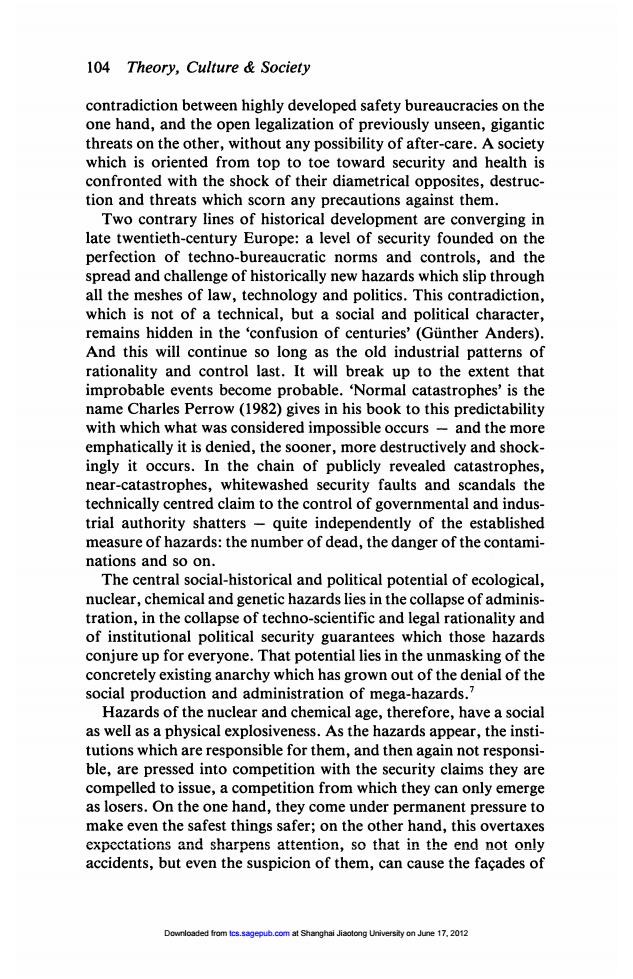
104 Theory,Culture Society contradiction between highly developed safety bureaucracies on the one hand,and the open legalization of previously unseen,gigantic threats on the other,without any possibility of after-care.A society which is oriented from top to toe toward security and health is confronted with the shock of their diametrical opposites,destruc- tion and threats which scorn any precautions against them Two contrary lines of historical development are converging in late twentieth-century Europe:a level of security founded on the perfection of techno-bureaucratic norms and controls,and the spread and challenge of historically new hazards which slip through all the meshes of law,technology and politics.This contradiction, which is not of a technical,but a social and political character, remains hidden in the 'confusion of centuries'(Gunther Anders). And this will continue so long as the old industrial patterns of rationality and control last.It will break up to the extent that improbable events become probable.'Normal catastrophes'is the name Charles Perrow(1982)gives in his book to this predictability with which what was considered impossible occurs-and the more emphatically it is denied,the sooner,more destructively and shock- ingly it occurs.In the chain of publicly revealed catastrophes, near-catastrophes,whitewashed security faults and scandals the technically centred claim to the control of governmental and indus- trial authority shatters -quite independently of the established measure of hazards:the number of dead,the danger of the contami- nations and so on. The central social-historical and political potential of ecological, nuclear,chemical and genetic hazards lies in the collapse of adminis- tration,in the collapse of techno-scientific and legal rationality and of institutional political security guarantees which those hazards conjure up for everyone.That potential lies in the unmasking of the concretely existing anarchy which has grown out of the denial of the social production and administration of mega-hazards.? Hazards of the nuclear and chemical age,therefore,have a social as well as a physical explosiveness.As the hazards appear,the insti- tutions which are responsible for them,and then again not responsi- ble,are pressed into competition with the security claims they are compelled to issue,a competition from which they can only emerge as losers.On the one hand,they come under permanent pressure to make even the safest things safer;on the other hand,this overtaxes expectations and sharpens attention,so that in the end not only accidents,but even the suspicion of them,can cause the facades of Downloaded from lcs.sagepub.com at Shanghai Jiaotong University on June 17,2012
Downloaded from tcs.sagepub.com at Shanghai Jiaotong University on June 17, 2012
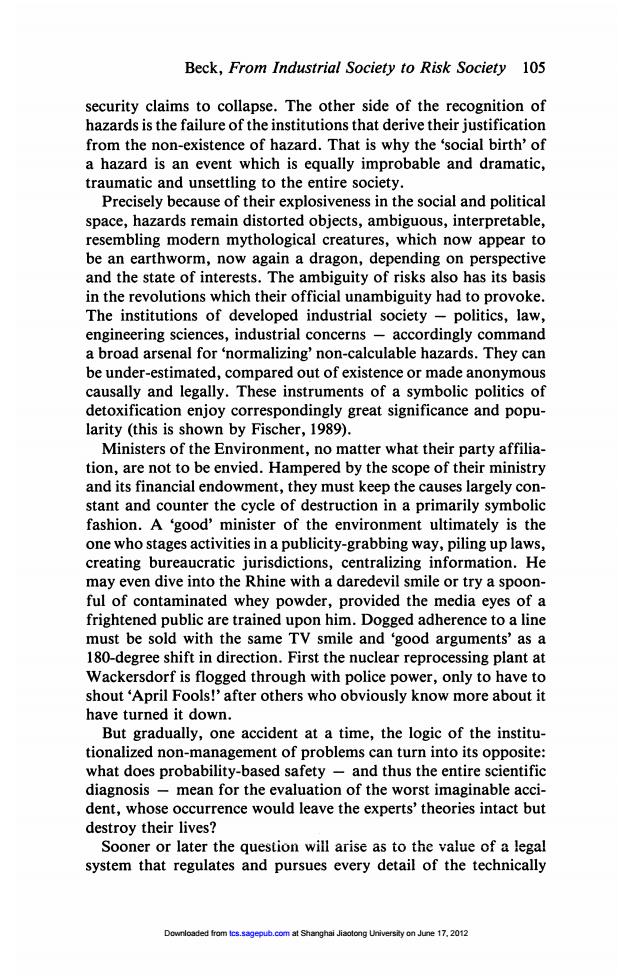
Beck,From Industrial Society to Risk Society 105 security claims to collapse.The other side of the recognition of hazards is the failure of the institutions that derive their justification from the non-existence of hazard.That is why the social birth'of a hazard is an event which is equally improbable and dramatic, traumatic and unsettling to the entire society. Precisely because of their explosiveness in the social and political space,hazards remain distorted objects,ambiguous,interpretable, resembling modern mythological creatures,which now appear to be an earthworm,now again a dragon,depending on perspective and the state of interests.The ambiguity of risks also has its basis in the revolutions which their official unambiguity had to provoke. The institutions of developed industrial society-politics,law, engineering sciences,industrial concerns-accordingly command a broad arsenal fornormalizing'non-calculable hazards.They can be under-estimated,compared out of existence or made anonymous causally and legally.These instruments of a symbolic politics of detoxification enjoy correspondingly great significance and popu- larity (this is shown by Fischer,1989). Ministers of the Environment,no matter what their party affilia- tion,are not to be envied.Hampered by the scope of their ministry and its financial endowment,they must keep the causes largely con- stant and counter the cycle of destruction in a primarily symbolic fashion.A 'good'minister of the environment ultimately is the one who stages activities in a publicity-grabbing way,piling up laws, creating bureaucratic jurisdictions,centralizing information.He may even dive into the Rhine with a daredevil smile or try a spoon- ful of contaminated whey powder,provided the media eyes of a frightened public are trained upon him.Dogged adherence to a line must be sold with the same TV smile and good arguments'as a 180-degree shift in direction.First the nuclear reprocessing plant at Wackersdorf is flogged through with police power,only to have to shout 'April Fools!'after others who obviously know more about it have turned it down. But gradually,one accident at a time,the logic of the institu- tionalized non-management of problems can turn into its opposite: what does probability-based safety-and thus the entire scientific diagnosis-mean for the evaluation of the worst imaginable acci- dent,whose occurrence would leave the experts'theories intact but destroy their lives? Sooner or later the question will arise as to the value of a legal system that regulates and pursues every detail of the technically Downloaded from lcs.sagepub.com at Shanghai Jiaotong University on June 17,2012
Downloaded from tcs.sagepub.com at Shanghai Jiaotong University on June 17, 2012

106 Theory,Culture Society manageable minor risks,but legalizes the mega-hazards by virtue of its authority,to the extent they cannot be minimized technically, and burdens everyone with them,including those who resist? How can a democratic political authority be maintained which must counter the escalating consciousness of hazards with energetic safety claims,but in that very process puts itself constantly on the defensive and risks its entire credibility with every accident or sign of an accident? The Role of Technology and the Natural Sciences in the Risk Society There is a public dispute over a new ethics of research in order to avoid incalculable and inhuman results.To limit oneself to that debate is to misunderstand the degree and type of involvement of the engineering sciences in the production of hazards.An ethical renewal of the sciences,even if it were not to become entangled in the thicket of ethical viewpoints,would be like a bicycle brake on an intercontinental jet,considering the autonomization of tech- nological development and its interconnections with economic interests.Moreover,we are not concerned merely with the ethics of research,but also with its logic and with the unity of culprits and judges (experts)of the engineering sciences in the technocracy of hazards. An initial insight is central:in matters of hazards,no one is an expert-particularly not the experts.Predictions of risk contain a double fuzziness.First,they presume cultural acceptance and cannot produce it.There is no scientific bridge between destruction and protest or between destruction and acceptance.Acceptable risks are ultimately accepted risks.Second,new knowledge can turn normality into hazards overnight.Nuclear energy and the hole in the ozone layer are prominent examples.Therefore:the advancement of science refutes its original claims of safety.It is the successes of science which sow the doubts as to its risk predictions. But conversely,it is also true that acute danger passes the mono- poly of interpretation to those who caused it,of all people.In the shock of the catastrophe,people speak of rem,Becquerels or ethylene glycol as if they know what such words mean and they must do so in order to find their way in the most everyday matters.This contradiction must be exposed:on the one hand the engineering sciences involuntarily enact their own self-refutation in their con- tradictory risk diagnoses.On the other,they continue to administer Downloaded from lcs.sagepub.com at Shanghai Jiaotong University on June 17,2012
Downloaded from tcs.sagepub.com at Shanghai Jiaotong University on June 17, 2012